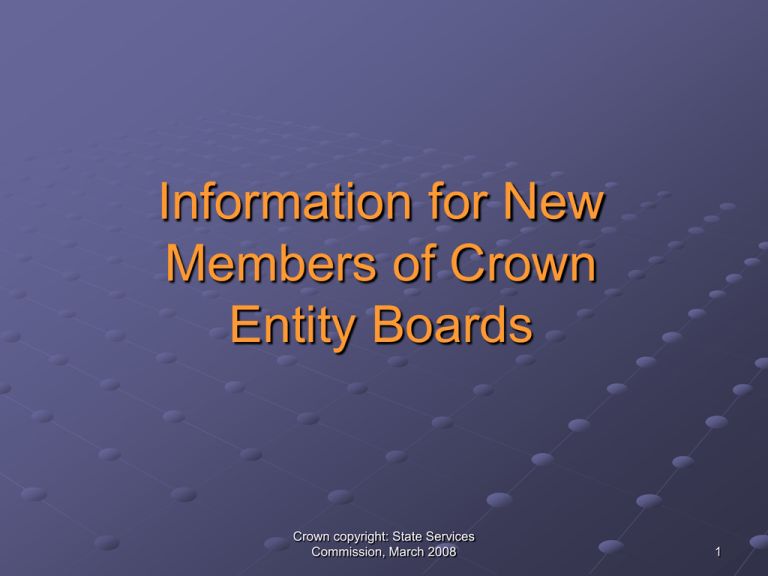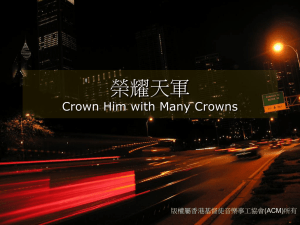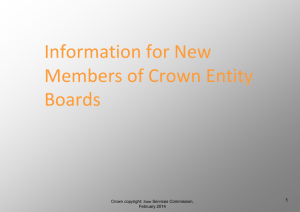Induction Programme Structure
advertisement

Information for New Members of Crown Entity Boards Crown copyright: State Services Commission, March 2008 1 Outline of content 1 What are Crown entities and where do they fit in the State services environment? 2 How do Ministers influence Crown entities? 3 Accountability and scrutiny of Crown entities 4 Developing effective relationships 5 Governing a Crown entity 6 Expectations of board members 7 Applying public sector values 8 Additional resources Crown copyright: State Services Commission, March 2008 2 2 Ministers influence Crown entities in various ways… Crown copyright: State Services Commission, March 2008 3 … through making board appointments Mostly made by Ministers; ICE board members are appointed by the Governor-General. Ministers’ recommendations for appointment almost always go to the Cabinet Appointments and Honours Committee and often to the government caucus. Appointments are for a fixed term. Appointees may be offered a second or subsequent term of office but there is no guarantee of this. Ministers and the Governor-General have powers of removal. No compensation or other benefit for loss of office. Crown copyright: State Services Commission, March 2008 4 … by participating in an on-going dialogue with entities.. For example: Meetings Ministers typically hold regular meetings with the board chair (or with senior management acting under authorisation from the board) to discuss strategic issues. Monitoring department representatives will often be present Ministers may also have periodic meetings with the full board Regular reporting There are requirements are in place for periodic reporting by entities Briefings For their part, boards are expected to advise their Minister in advance of any major initiatives or developments See also ‘no surprises’ Ideally, informal engagement between boards and responsible Ministers should precede and inform Crown copyright: Statemore Servicesformal processes Commission, March 2008 wherever possible. 5 The Managing For Outcomes/Results Cycle … by participating in formal strategic direction setting processes, for which there are various channels… (1) Letter of Expectation This can be a valuable way to initiate the strategic planning process and is often the subject of prior consultation between Minister and entity A letter of expectation sets out a Responsible Minister’s expectations for: The Crown entity’s strategic direction Its governance and performance; and His/her specific priorities for the planning period Monitoring and information expectations Crown copyright: State Services Commission, March 2008 7 (2) Statement of Intent (SOI) The SOI is the centrepiece of the accountability relationship between a Crown entity board and its Minister Through the preparation of its SOI a board outlines its strategic thinking and future intentions, and frames its actions (it is expected that the SOI process will be driven by the board, not by management) Should reflect Government objectives for both the sector and for individual Crown entities, and wider Government policy initiatives and themes Ministers should be given sufficient time to review and comment on drafts. Within limits, as set out in the CE Act, they may direct SOI content Crown copyright: State Services Commission, March 2008 8 Through various other processes and agreements, such as … Output agreements Detail the outputs to be supplied, including those paid for by third parties where the Minister has some responsibility for setting fee levels or service specifications Memoranda of Understanding (MOU) Mostly used to document the Government’s performance expectations of a Crown entity and enable the Minister and the entity to record their understanding of the basis for monitoring, and accountability of the entity. The MOU supplements the SOI Annual Report An assessment of performance against that outlined in the SOI Ongoing performance reporting, eg quarterly reports Crown copyright: State Services Commission, March 2008 9 And by monitoring Crown entity performance… Ministers ‘oversee and manage’ Crown entities (and are answerable to Parliament for their entities’ performance) They obtain advice from monitoring departments about the entities' effectiveness and efficiency, and how any risks will be managed Ministers can require Crown entities to supply a wide range of information They rely on good reporting from the entity and are assisted by monitoring departments as their agents Ministers are also able to formally review a Crown entity’s operations and performance at any time Crown copyright: State Services Commission, March 2008 10 Ministers have powers to direct some Crown entities Ministers may direct a Crown Agent or ACE (eg, in relation to policy or implementation). Powers of direction are likely to be used infrequently, and there are limits on the ability to direct. Ministers must consult with the affected entity Whole of Government directions may be issued Directions must be in writing. They are tabled in Parliament and notified in the Gazette. Crown copyright: State Services Commission, March 2008 11





